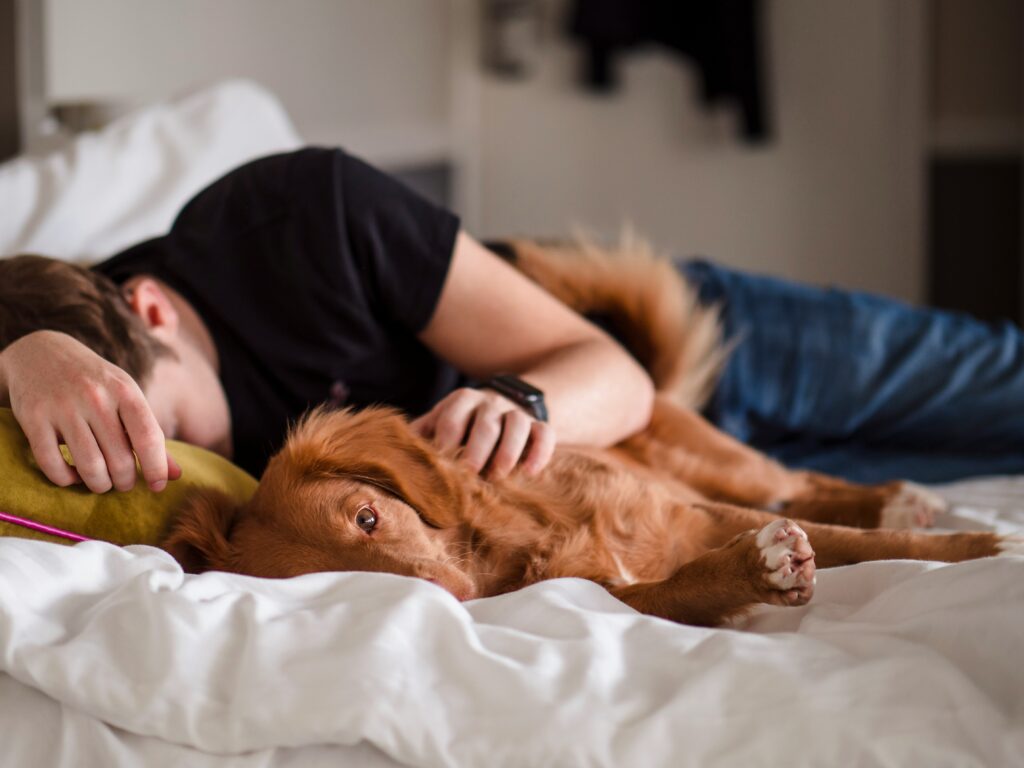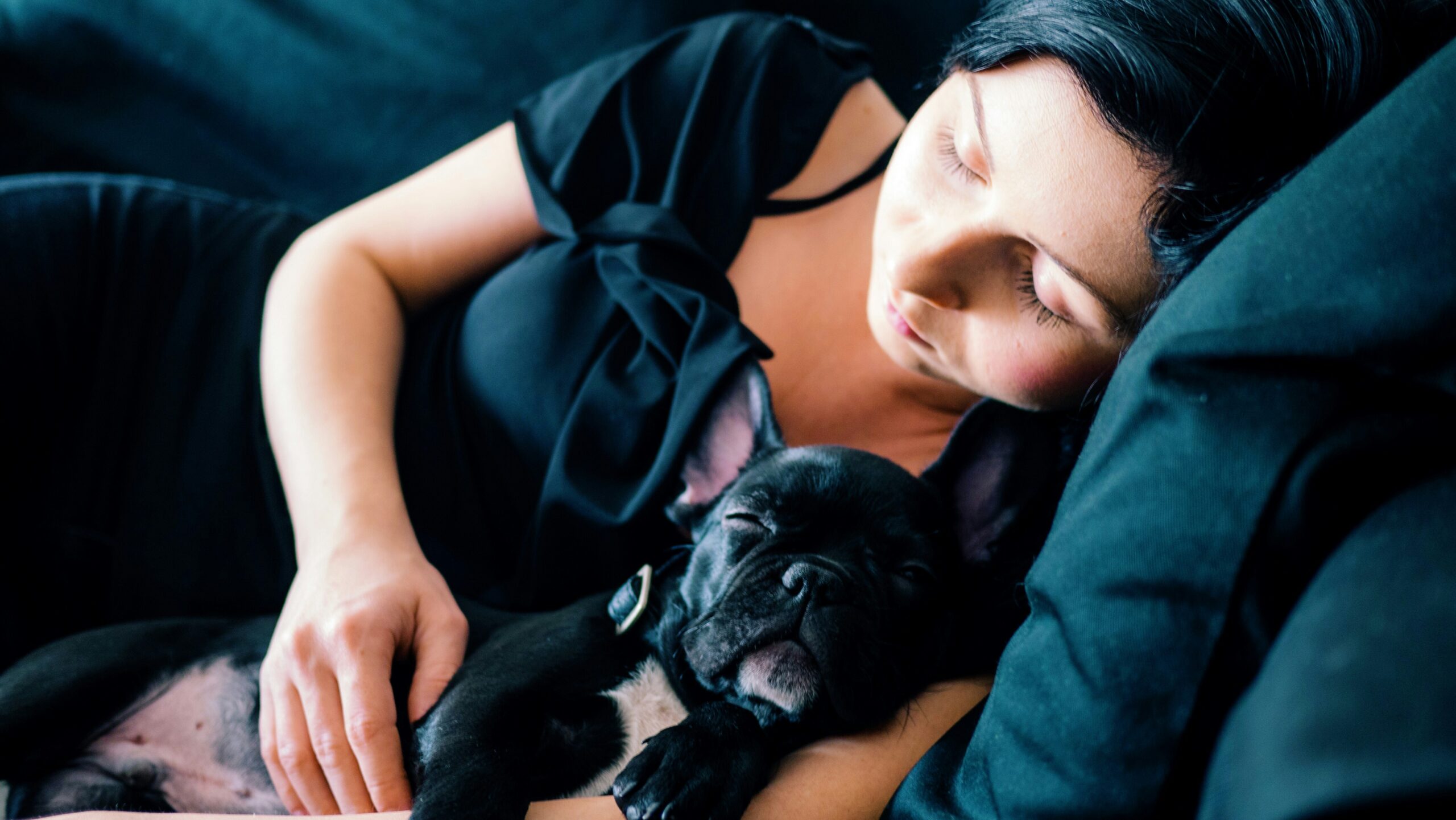Sharing your sleeping space with your furry friend can be a heartwarming experience, but finding the perfect dog sleeping positions that work for both you and your canine companion requires some thoughtful consideration.
In this guide, we’ve rounded up 10 valuable tips to enhance those cozy moments of shared slumber.
Learn how to create the ideal sleeping setup for you and your dog, fostering comfort and a deeper bond through harmonious sleep.
Table of Contents
Sweet Dreams: Dog Sleeping Positions with Owner

1] Know Your Dog’s Preferred Position
Understanding your dog’s preferred sleeping positions is crucial for tailoring their sleep environment.
Some dogs enjoy curling up, while others prefer stretching out or leaning against something.
Observing and recognizing these preferences allow you to arrange bedding and sleeping spaces to accommodate their unique comfort needs.
This knowledge enables you to create an environment that aligns with your dog’s natural inclinations, promoting restful sleep.
2] Cozy Bedding
Investing in cozy bedding goes beyond providing mere comfort—it creates a sanctuary for your dog’s rest.
Soft blankets, plush cushions, or a designated dog bed contribute to a snuggle-worthy space.
Consider the material and thickness of the bedding to match your dog’s preferences.
This dedicated sleeping area becomes a comforting haven, enhancing the overall sleep experience for your canine companion.
Tip: “Designate a dog bed that accommodates both you and your furry friend for shared comfort.”
3] Establish a Bedtime Routine
Dogs thrive on routine, and bedtime is no exception. Creating a bedtime routine sets the stage for restful sleep.
Whether it involves a short evening walk, gentle playtime, or quiet cuddles, a consistent routine signals to your dog that it’s time to wind down.
This predictability helps them transition into a state of relaxation, preparing both their mind and body for a night of peaceful sleep.
4] Respect Your Dog’s Space
While many dogs enjoy close contact, it’s crucial to respect their need for personal space during sleep.
Allow your dog to choose their preferred sleeping spot—whether it’s at the foot of your bed, nestled beside you, or in their designated sleeping area.
This autonomy encourages comfortable sleeping positions, ensuring your dog feels secure and content in their chosen space.
Tip: “Encourage comfortable sleeping positions, whether at the foot of the bed or in their designated area.”
5] Provide Gentle Affection
Before settling down for the night, indulge in a bedtime ritual of gentle affection.
Petting, belly rubs, or a few reassuring words create a positive association with bedtime.
This nightly ritual not only brings joy to your dog but also strengthens the emotional bond between you and your furry friend.
The warmth of your affection becomes an integral part of their bedtime routine, fostering feelings of security and love.
6] Temperature Comfort

Dogs are sensitive to temperature variations, and maintaining an optimal sleeping environment is crucial for their well-being.
Ensure that the sleeping area is neither too hot nor too cold.
Adjust blankets, provide adequate ventilation, or consider using a fan to regulate the temperature.
Striking the right balance ensures your dog enjoys a comfortable sleep, free from discomfort caused by temperature extremes.
Tip: “Adjust blankets or provide a fan to cater to your dog’s sensitivity to temperature changes.”
7] Adapt to Changes
As your dog ages or experiences changes in health, it’s essential to adapt their sleeping arrangements to cater to evolving needs.
Senior dogs may benefit from orthopedic beds to support achy joints, while dogs with arthritis might find softer bedding more comfortable.
Regularly assess your dog’s physical condition and make necessary adjustments to ensure their continued comfort as they age.
This adaptability reflects your commitment to meeting their changing requirements.
8] Incorporate Familiar Scents
Infusing the sleeping area with familiar scents contributes to your dog’s sense of comfort.
Placing a piece of your clothing or including their favorite toy imparts a familiar and reassuring aroma.
This symphony of comforting scents creates an environment reminiscent of safety and familiarity, helping your dog feel secure and relaxed as they drift into sleep.
Tip: “Create a symphony of comfort with scents that provide security and reassurance.”
9] Maintain a Calm Environment
Creating a calm and quiet sleeping environment minimizes disruptions that could interrupt your dog’s rest.
Dogs, like humans, benefit from a serene atmosphere for quality sleep.
Ensure that the sleeping area is free from loud noises, bright lights, or sudden disturbances.
By minimizing disruptions, you contribute to uninterrupted, deep sleep, promoting overall well-being for your canine companion.
10] Join in the Cuddle
When your dog invites you to share their sleeping space, embrace the joy of a shared sleep experience.
Whether it’s a gentle snuggle or a full-on cuddle, relish the precious moments of closeness and companionship during the night.
This shared sleep not only enhances the emotional bond between you and your dog but also provides a sense of security and comfort for both parties.
Enjoying these moments strengthens the unique connection you share with your loyal and loving canine friend.
Tip: “Enjoy precious moments of closeness and companionship during the night’s gentle embrace.”
Dog Sleeping Positions with Owner: FAQs
Can all dogs sleep in bed with their owners?
While many dogs enjoy sleeping in bed with their owners, individual preferences vary. Some dogs may prefer their own sleeping space. Pay attention to your dog’s cues and respect their choices.
Is it healthy for dogs to sleep with their owners?
In general, sleeping with your dog can be a healthy and positive experience. It promotes bonding and provides a sense of security for your dog. However, consider factors such as allergies or sleep disturbances and make decisions based on individual circumstances.
How can I address any sleeping issues with my dog?
If your dog experiences sleeping issues, such as restlessness or discomfort, consult with a veterinarian. They can help identify underlying issues and provide guidance on creating a sleep-friendly environment.
Can a bedtime routine improve my dog’s sleep?
Yes, establishing a bedtime routine can positively impact your dog’s sleep. Consistency in activities and timing signals to your dog that it’s time to wind down, promoting a restful night.
One Dog Owner’s Delight:
In a heartwarming story shared by a dog owner, they recount the joy of adapting their bedtime routine to accommodate their aging dog’s needs. By incorporating a cozy orthopedic bed and maintaining a calming atmosphere, they created a haven of comfort for their beloved furry friend.

Conclusion
As you embark on the journey of perfecting Dog Sleeping Positions with Owner, remember that it’s all about creating a sleep haven for both you and your furry friend.
With the 10 tips shared in this guide, you can ensure a restful and enjoyable sleep routine.
From finding the right sleeping arrangement to incorporating cozy elements, these strategies will contribute to a peaceful night’s sleep, strengthening the special connection between you and your dog.
Embrace the comfort, cherish the shared moments, and may your nights be filled with sweet dreams and canine companionship.





